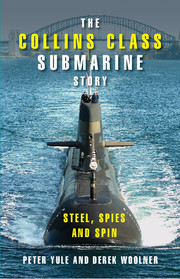Book contents
- Frontmatter
- Contents
- List of key people
- List of acronyms
- Introduction
- Part 1 You Can't Build Submarines in Australia
- Part 2 The Honeymoon Years 1987–92
- Part 3 ‘A Strange Sense of Unease” 1993–98
- 17 End of the honeymoon
- 18 The trials of Collins
- 19 ‘They were problems we didn't expect”
- 20 The role of Defence Science: noise and diesels
- 21 ‘A patch on this and chewing gum on that’: the combat system 1993–97
- Part 4 Resolution
- Notes
- Index
21 - ‘A patch on this and chewing gum on that’: the combat system 1993–97
Published online by Cambridge University Press: 05 September 2013
- Frontmatter
- Contents
- List of key people
- List of acronyms
- Introduction
- Part 1 You Can't Build Submarines in Australia
- Part 2 The Honeymoon Years 1987–92
- Part 3 ‘A Strange Sense of Unease” 1993–98
- 17 End of the honeymoon
- 18 The trials of Collins
- 19 ‘They were problems we didn't expect”
- 20 The role of Defence Science: noise and diesels
- 21 ‘A patch on this and chewing gum on that’: the combat system 1993–97
- Part 4 Resolution
- Notes
- Index
Summary
In 1993 the submarine project office told ASC that the combat system would be delivered in two stages – the first stage (release 1.5) sufficient for the first submarine's trials, with the second stage (release 2) being the complete system to be delivered for the trials of the second submarine. Throughout the period 1993 to 1997 this remained the plan, but the delivery of stage two increasingly seemed like a mirage, shimmering in the distance, while the submarine project staggered thirstily through the desert of endless ‘releases’ and ‘drops’ of successive versions of stage one. As the contractors and the project office tried desperately to cobble together a system that would allow the submarines to go to sea, the hopes that had inspired the ambitious specifications for the ‘world's best combat system’ seemed distant indeed.
The project office's quarterly reports chart the story of the incremental releases, together with the ever more distant delivery of the complete combat system and the steady elimination of the more demanding requirements.
In September 1993 Computer Sciences was testing release 1.5 of the combat system software and ‘to date there do not appear to be any fundamental problems’, although ‘the overall stability of the combat system remains a concern’. Three months later ‘the stability of the release 1.5 tactical data handling system software continues to be of concern' and the system was regularly crashing.
- Type
- Chapter
- Information
- The Collins Class Submarine StorySteel, Spies and Spin, pp. 244 - 254Publisher: Cambridge University PressPrint publication year: 2008



